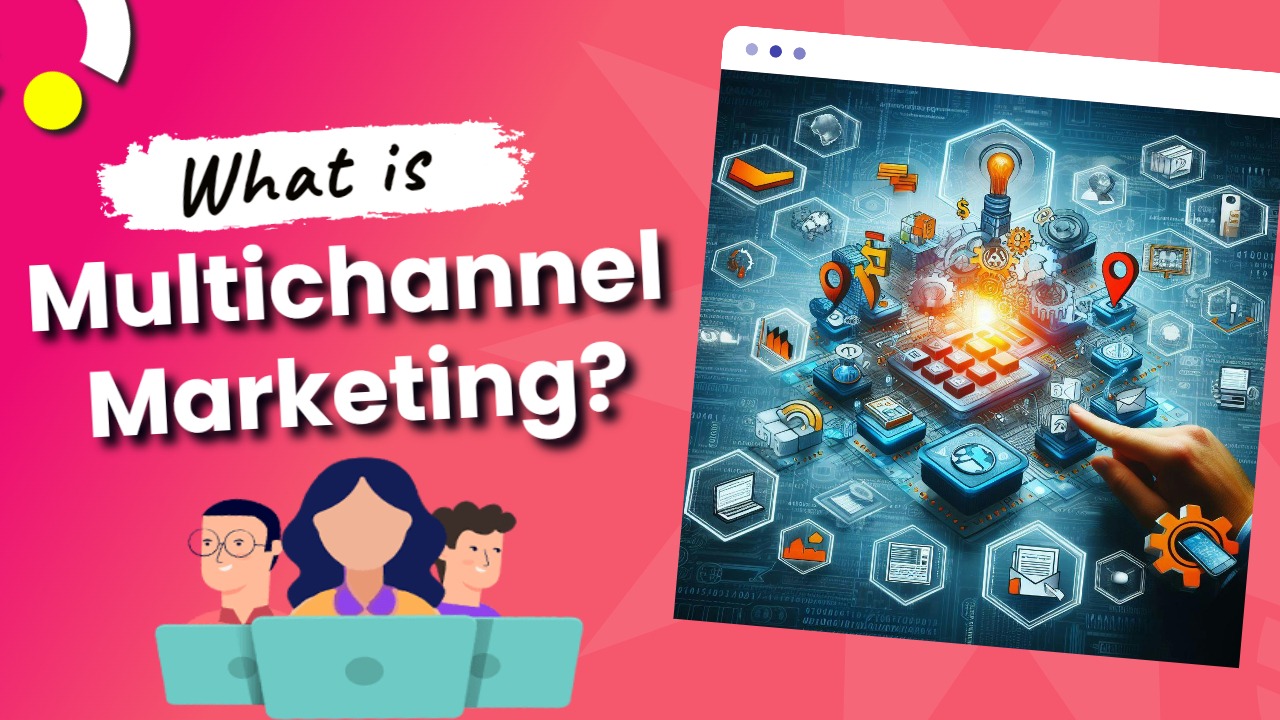
Multichannel marketing is a strategy that businesses use to interact with their customers across multiple platforms or channels. This can include various touchpoints like websites, email, mobile apps, physical stores, social media, and more. The main aim of this approach is to enable the customer to take action in response to the company's communication regardless of the channel they are using. This helps create a personalized image, build an audience and boost sales.
Multichannel Marketing Campaigns
When multichannel marketing, you are spreading your brand's message across various avenues, such as email, social media and mobile applications. The aim is to maximize customer reach and boost brand recognition at the same time.
To create a successful multichannel campaign, you must identify your target audience or buyer persona. This will guide you in selecting which platforms to utilize and what messaging to use in order to engage with them.
Create a comprehensive data collection and delivery strategy to guarantee you capture the right information at the appropriate time. Automation such as trigger emails can help simplify this process for data collection and delivery.
Another aspect of a successful multichannel campaign is to analyze it frequently and adjust your goals as necessary. This could involve refocusing on personas, altering channels, or altering budget and spend according to what needs to be changed.

Multichannel marketing enables brands to meet customers where they are and provide an effortless shopping experience. For instance, JC Penney sells items online through their website and displays its catalog on Facebook so people can buy items quickly from them.
Vrbo also distributes user generated content like photos of vacations booked using its application on social media networks in an effort to raise brand awareness. By creating a consistent experience across different platforms, companies can foster customer retention and reengagement through repeat business.
Why is Multichannel Marketing Important?
As the world continues to evolve, more and more consumers are engaging with brands in unique ways. As such, traditional marketing tactics like TV ads or email can no longer keep up with consumer buying habits.
Marketers are now leveraging multiple channels and platforms to get their brand in front of customers and boost conversions. This approach, known as multichannel marketing, is becoming increasingly popular.
By utilizing various channels effectively, marketers can conveniently target their desired audience, lowering churn rates and increasing customer retention.
An effective multichannel marketing strategy not only fosters brand loyalty and builds a following but also attracts more customers and improves business reputation leading to higher long-term sales levels.
Another advantage of a multichannel approach is that it enables businesses to craft consistent messages across different media. This can be especially advantageous when targeting audiences with distinct psychographics and purchase histories.

In addition, employing a multichannel marketing strategy allows brands to gather customer data from various interaction points. This data can be used to assess performance and implement adjustments when needed.
Finally, brands looking to maximize their return on investment (ROI) may find a multichannel approach highly advantageous. This can be accomplished through using a customer data platform that enables businesses to connect with customers wherever they are located.
Multichannel Marketing Example
In a pioneering multichannel marketing campaign, a leading beauty brand seamlessly integrated online and offline channels to create an immersive customer experience. Leveraging social media platforms, the brand initiated a captivating Instagram campaign featuring user-generated content showcasing diverse beauty routines. Simultaneously, they launched an augmented reality (AR) app allowing users to virtually try on products, fostering engagement beyond the confines of traditional brick-and-mortar stores.
To bridge the digital and physical realms, the brand strategically placed QR codes in-store that directed customers to exclusive online tutorials and promotions, creating a cohesive brand journey across channels. This innovative approach not only boosted online sales but also drove foot traffic to physical stores, highlighting the success of a synergistic multichannel strategy.
3 Main Ways to Approach Marketing
As the marketing world continuously changes, businesses must remain flexible and adaptable. One way to do this is through multichannel marketing - which enables companies to reach more customers at higher frequencies.
Companies have the unique opportunity to optimize their marketing initiatives through audience insight and analytics, ensuring their campaigns reach the right people at precisely the right time.
The initial step to a successful multichannel marketing strategy is understanding your target market and buyer persona. This will enable you to determine which channels are most efficient, while providing valuable demographic data that can assist in making informed decisions about advertising spend.

Another essential step is creating a marketing plan for the channels you select. Your campaign objectives should be clearly identified, and each marketing channel selected should have an inherent connection to that ultimate objective.
If your goal is to raise product awareness, your strategy could include informing potential buyers about your items and the advantages they provide. This can be accomplished through content marketing and referral programs.
Multichannel approaches can also be employed to foster brand loyalty by offering customers a unified experience across various channels, such as email, direct mail, social media and other platforms.
Benefits of Multichannel Marketing
Multichannel marketing is a type of marketing strategy that incorporates both inbound and outbound marketing strategies into one cohesive strategy. By combining these two methods, a company is able to reach potential customers through multiple channels and increase conversion rates. A multichannel marketing strategy can also increase customer satisfaction by creating brand consistency and streamlining the customer journey.
Multichannel marketing combines inbound and outsourced marketing strategies to create a more effective marketing strategy. Instead of relying on direct contact to reach your target audience, multichannel marketing helps businesses reach a greater number of prospects while boosting the presence of customer service teams across multiple channels. This method also improves customer relationship management initiatives, as it encourages companies to boost their presence on various channels.
Multichannel marketing is an excellent way to maximize marketing efforts and grow your business. It takes into consideration the unique needs of each consumer and allows you to meet them where they are. By using multiple marketing strategies, you can maximize your brand's visibility, improve your conversion rates, and increase your customer satisfaction.

It Personalizes the User Experience
In omnichannel marketing, a brand uses various channels to interact with its customers. This approach allows brands to leverage their customer data from different channels and tailor the experience to the individual user. Consequently, omnichannel personalization can help e-retail brands achieve higher customer engagement.
For an omnichannel marketing strategy to succeed, a brand needs to focus on the five main touchpoints between a customer and a brand. In addition, personalization should be consistent across channels. For example, if a customer visits a jewelry website but doesn't buy anything, they may receive an email with a discount offer based on their behavior. A brand may also send a personalized WhatsApp message to a customer who missed an email from the company. Personalized content can increase customer engagement and boost conversion rates.
To personalize the user experience across all channels, a brand must combine data from different sources and keep it in one place. This means establishing an integrated data hub to consolidate customer data across different channels.
Increases Sales
Multichannel marketing helps businesses reach customers in a variety of ways. Many consumers are using multiple digital platforms to make purchases, and it is important to be present in all of these channels. The bottom line: if you're not reaching your customers, you're missing opportunities to build brand awareness and increase sales. In fact, consumers who engage with brands through multichannel marketing tend to make more purchases and spend more money than those who only buy a product through a single channel.

To better understand your customers, you need to understand the behaviors and interests of your target audience. You can do this by creating a customer persona. Your persona can include information such as demographics, interests, pain points, and purchase patterns. For example, you might create a persona for a new online athleisure wear boutique. Jill, for example, might be looking for leggings for both workouts and loungewear, and she might shop at Lululemon and Athleta to find those pieces.
Once you have determined your target audience, you can begin your multichannel marketing strategy. Start by choosing the channels that your target audience uses the most. For example, most adults check their cell phones more than 100 times a day, so Facebook might be an ideal platform to target Jill. SMS messaging may also be a good option for reaching Jill. However, it's important to know the rules regarding SMS messaging. And remember to create an opt-in process that is legal and compliant.
A Drawback to Multichannel
Measurement of multichannel marketing is a challenging task. Marketers seek evidence-based results in order to choose the best methods of reaching consumers and improving business performance. However, the complexity of multichannel marketing makes it difficult to accurately attribute marketing efforts to the conversions they drive. This article will look at the three major types of responses from users and the ways they can be used to measure success.
One of the main challenges of multichannel marketing is that it is difficult to measure brand reach and consistency, which makes it difficult to determine which channels are most effective. Thankfully, there are sophisticated methods that help marketers monitor their multichannel marketing campaigns. One such method is to run a display/mobile campaign for customers, which captures their attention while browsing across multiple devices.
Besides understanding which channels are most effective, multichannel marketing also involves testing different messages. For example, social media works well for top-of-funnel videos, while SMS is a good option for flash sales. Furthermore, digital platforms usually offer higher ROIs compared to traditional channels.

What is Omnichannel Marketing?
We touched upon it already, but what exactly is it? Omnichannel marketing refers to the utilization of multiple channels for communicating brand messages and creating customer experiences across different devices. This strategy increases customer engagement, loyalty, and convenience throughout the buying journey - leading to increased revenue and loyalty over time.
The initial step in crafting an omnichannel strategy is to understand your target audience. This includes understanding their demographics, where they come from, and how they respond to communications you send them. Based on this understanding, you can then construct your omnichannel approach around it.
Customers who engage with multiple touchpoints are 30% more valuable and often contribute 40% of your overall revenue. This is because they're more likely to purchase from you again and possess a deeper knowledge of your brand.
Retailers are employing omnichannel strategies in multiple ways to enhance customer experience and boost sales. In addition to making products accessible on websites and mobile apps, retailers are adding various customer service options as well as streamlining online payment processes.
Illustration of an Omnichannel Approach
An omnichannel example is ride-sharing services like Uber and Lyft, which have added features like ordering a ride, finding a nearby location, and receiving text notifications when the driver has arrived. These customer-centric offerings enhance the overall experience while helping reduce churn rates.
To guarantee your omnichannel strategy is successful, ensure each channel and touchpoint are in alignment with your brand. This can be accomplished through A/B testing, which will reveal what types of creative, copywriting, and offers resonate most with your target audience.
Omnichannel Marketing vs Multichannel Marketing
In today's ever-changing customer journey, brands must provide a consistent and unified experience for customers. That is where Omnichannel comes into play.

Customers visiting your website from desktop or mobile device, or walking into a store after work, experience an integrated experience across all channels. They can contact your support team through social media and have their request escalated to a phone call without losing context data from previous interactions with you.
By employing this strategy, you can reach more customers and foster loyalty and trust in your brand. Furthermore, you'll be able to deliver tailored messages and offers at each step of your customers' shopping experience.
To achieve this, you need a central source of data that allows your teams to monitor customer behavior and use that knowledge to personalize each interaction. This is what differentiates omnichannel from multichannel marketing.
Multichannel marketing entails reaching your customers through various channels, such as mobile apps, email and online advertising. While this strategy can be successful, it's not as efficient as an integrated omnichannel approach. Adopting this solution helps your business remain competitive and ultimately boost revenue growth over time; additionally, it frees employees to focus on providing customers with a superior experience.
Final Thoughts
Multichannel marketing is no longer a luxury but a necessity in today's hyper-connected world. It offers businesses the chance to interact with their customers on different platforms and deliver a seamless and consistent experience. By executing a well-planned multichannel marketing strategy, businesses can increase their reach, improve customer engagement and drive higher sales.
However, companies must ensure that they are delivering the right message through the right channel at the right time to achieve optimal results. As the digital landscape continues to evolve, businesses should keep adapting their strategies to leverage the full potential of multichannel marketing.
Frequently Asked Questions
What is multi-channel marketing vs cross-channel marketing?
Multi-channel marketing uses multiple channels (email, social media, website, etc.) to reach customers independently. Cross-channel marketing connects these channels to create unified customer experiences, sharing data and maintaining consistency across touchpoints.
How do I choose the right marketing channels?
Analyze your target audience's preferences and behaviors, evaluate your resources and budget, then select channels that align with both. Start with 2-3 core channels and expand based on performance.
What metrics should I track?
Track channel-specific metrics (email open rates, social engagement) and cross-channel metrics (customer lifetime value, attribution). Focus on ROI and conversion rates to optimize resource allocation.
How often should I communicate across channels?
Base frequency on channel norms and audience engagement. Email might be weekly, social media daily, and SMS monthly. Monitor engagement metrics and adjust accordingly.

 Add Row
Add Row  Add
Add 



